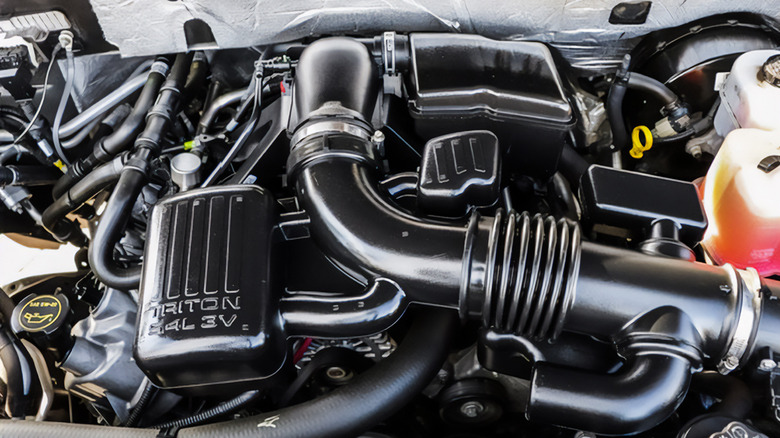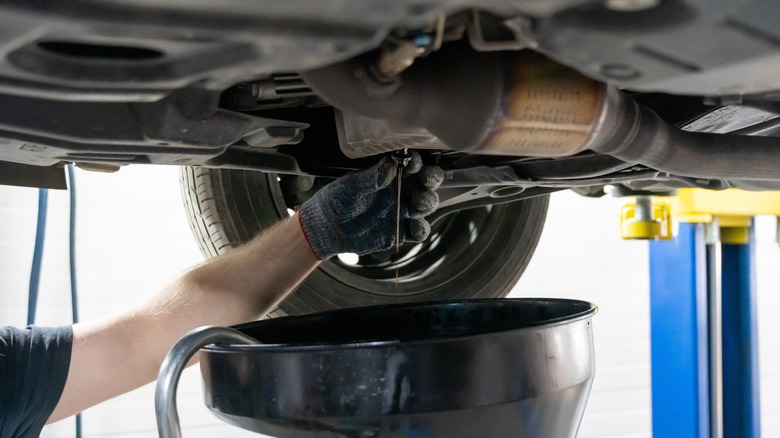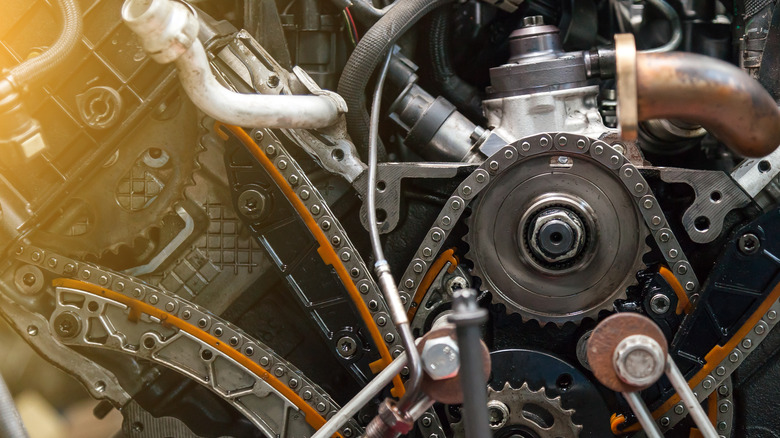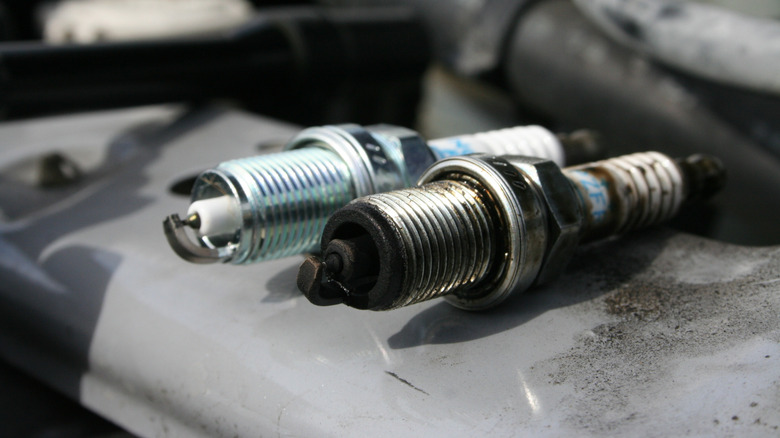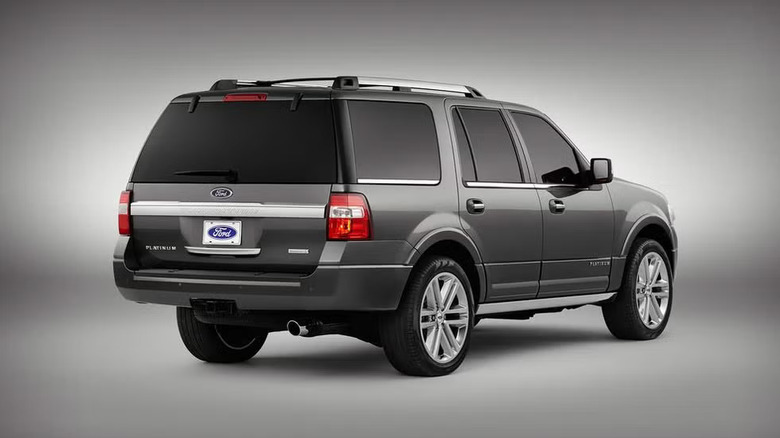Common Problems With The Ford 5.4 Triton Engine
We may receive a commission on purchases made from links.
Some people have described the Ford 5.4L Triton engine as "one of the worst V8's ever produced." And while it didn't make it onto our list of the three worst V8 engines, there's still some credibility to the criticisms. Even though the vehicles it powered are popular, like F-150s from the 2000s, the engine itself has a rocky reputation.
Introduced in 1997, the 5.4L Triton engine was primarily used in Ford trucks and SUVs, but it was later adapted for sports cars like the Ford Shelby GT500. The last model to use it was the 2014 Ford Expedition. Across its 17-year run, the 5.4L Triton engine can be separated into two main generations. The first was a 2-valve design that was used from 1997 until 2004. The second was a 3-valve design that was used from 2004 to 2014. A 4-valve design was also released for use in a handful of sports cars.
Ford never issued any recalls specific to the 5.4L Triton, though it did release dozens of technical service bulletins related to the engine throughout the years. Some were unique to specific versions of the engine, such as a rough idle associated with the 3-valve version (TSB 12-7-10). Other problems are more general and could be found across the different generations and versions, such as spark plug issues. Perhaps the most notorious general issue is the 5.4L Triton's affinity for poor engine timing, which can be caused by numerous faulty components, from the timing chain to the tensioners. While the minor issues can occur at any time, the more serious problems usually pop up at high mileages — and some of them are a death sentence for the engine.
Oil problems: sludge buildups and leaky gaskets
Thanks to synthetic oils, mechanics recommend replacing your oil every 7,500 to 10,000 miles. But the Ford 5.4L Triton is an exception — more frequent oil changes are critical. Some service guides for the 5.4L Triton recommend an oil change every 3,000 to 5,000 miles. That's about half the standard recommended interval for an oil change. Many owners of both generations across the web agree, pointing out the necessity in changing the oil every 3,000 miles to avoid problems.
Most of the common problems with the Triton, such as poor engine timing and spark plug issues, are often caused by the engine's lubrication struggles. Some critics argue that the engine's oil passages are too small, while others point out the inadequate power of the oil pump. The reason is probably a combination of several design flaws, but whatever the culprit may be, the frustrating results are the same. Sludge and debris build up quickly in the Triton, especially around the cylinder heads. And when the cylinder heads are gunked up, the rest of the system suffers, too. Tensioners, camshaft phasers, and other components will fail without sufficient lubrication. They'll let you know, too, with a distinct knocking sound.
But oil issues aren't just confined to the engine's interior. The oil pan gasket can fail and leak onto the exhaust. If it happens, it's not the end of the world, since it can be replaced fairly cheaply. However, this failure is one of the few common problems with the 5.4L Triton that can occur early on, even at low mileage, so it serves as a harbinger for more serious problems to come.
Poor engine timing: three problems in one
The 5.4L Triton has many common issues, but poor engine timing is possibly the most notorious of all. There are surefire ways to tell if the timing belt itself is the problem. However, the Triton's timing problems are usually caused by three major designs flaws in the surrounding components. For one, the chain guides tend to wear down due to friction with the timing chain. This friction loosens the timing chain, which in turn further degrades the guides. The result is a snowball effect, in which both the chain and the guides grind each other down, all the while ejecting shavings of plastic and metal into the bay. In the Triton, the plastic timing chain guides and cover sometimes disintegrate entirely.
Secondly, the Triton's timing chain tensioners are also known to fail after enough time on the road. On an already-loose timing chain, the tensioners may blow out completely. Failed tensioners make a grinding, rattling sound, particularly at lower speeds and temperatures. Some owners report that when the tensioners fail, the loosened chain can grind through the timing cover, rails, and, eventually, the oil pump.
Thirdly, the 5.4L Triton's cam phasers have a knack for breaking. In fact, camshaft-phaser breakages were such a problem with early Tritons that Ford revised the design 40 times over the course of the engine's production life. Since cam phasers are critical to the synchronization of the camshaft and the crankshaft, broken ones will cause immediate timing problems.
Spark plug problems
Spark plug problems are another common complaint surrounding the Ford 5.4L Triton engine. Yet, while replacing spark plugs is a cheap and easy fix, 5.4L Triton has a much more expensive problem: the spark plugs tend to shoot right out of the cylinder heads. The spontaneous ejection of spark plugs was a common issue among certain early Triton models, particularly the first generation.
This was likely thanks to the two-valve engines only having four threads in each cylinder head. Four aluminum threads apparently aren't enough for an engine with up to 260 horsepower and 350 lb-ft of torque. When the spark plugs self-eject from the cylinder heads, the repair isn't as simple as putting them back in. That's because the cylinder head threads can be damaged by the blow-out, and it can even result in engine fires. The fix is an expensive rethreading or an entire replacement of the cylinder head.
When Ford released the 3-valve engine, the blown-out spark plug problem seemed to have been corrected. However, the V3 series introduced an entirely new spark plug fiasco. Owners discovered a tendency for the spark plugs to break apart when removing them, leaving behind burnt bits of charred spark plug in the cylinder heads. When the spark plugs break during removal, the solution is a bit cheaper. Depending on the amount of broken bits left inside the cylinder head, you can typically extract the debris on your own. There are broken spark plug removal kits that you can buy for less than 100 bucks, like this one from Lisle, so DIY is almost always cheaper than hiring a mechanic.
Fuel frustrations: high emissions and faulty fuel pumps
The 5.4L Triton's problems with fuel are twofold. For one, many models with the V3 engine had widespread fuel pump failures. This failure often occurred early on in the vehicle's service life, since the root of the issue was a sensitivity of the fuel pump driver module to corrosion. That sensitivity was the result of a blaring design flaw.
In early 3-valve models, the driver module was mounted in direct contact with the vehicle's metal frame. The module was poorly weatherproofed, so salt and water could easily start corroding the module's aluminum housing. Once the housing was compromised, those corrosive elements would then enter the module and wreak havoc on the electronics. And once that happens, a fuel pump failure is imminent. Eventually, Ford updated the design by improving the weatherproofing of the module. The company also made DIY kits available for purchase, which provide spacers to eliminate contact between the module and the frame.
The other fuel problem with the 5.4L Triton is its poor fuel economy. By the time the Triton was finally retired after the 2014 Expedition, the engine's dated design was struggling to meet modern emission regulations. It seems that Ford saw the writing on the wall. Rather than redesigning the entire engine, Ford swapped the Triton out with new, more efficient engines, such as the 3.5-liter EcoBoost.
